Title: Lilongwe to Songwe River (Malawi – Tanzania border)
Dates: 20th to 26th May GPS:
Distance: 662km Total Distance: 15,683km
Roads: Good tarmac except 90km rough unsealed, mud Rumphi to Livingstonia
Weather: Perfect! Mid-high 20s, cooler nights in mountains
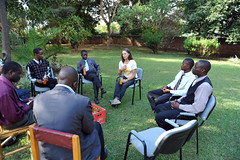 John and I had a day’s pit stop staying at the headquarters of Globe Metals and Mining in Lilongwe. Michael, Dominic and Dries made us feel very welcome as we prepared for the next stage, caught up with emails, sent packages back to Australia, fixed bike and LandRover, and had a physical rest. I also did some PR work for Globe in the afternoon, meeting the Deputy Director of Mines, Mr Wona, and his small delegation. Michael, Dominic and I chatted with the group for about an hour or so sitting in Globe’s beautiful back garden. The day passed quickly and soon we were off again, heading north out of the city along the main road.
John and I had a day’s pit stop staying at the headquarters of Globe Metals and Mining in Lilongwe. Michael, Dominic and Dries made us feel very welcome as we prepared for the next stage, caught up with emails, sent packages back to Australia, fixed bike and LandRover, and had a physical rest. I also did some PR work for Globe in the afternoon, meeting the Deputy Director of Mines, Mr Wona, and his small delegation. Michael, Dominic and I chatted with the group for about an hour or so sitting in Globe’s beautiful back garden. The day passed quickly and soon we were off again, heading north out of the city along the main road.
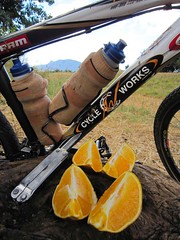 My goal for the first day was to reach the turn off to Globe’s Kanyika exploration camp, 166km from their Lilongwe headquarters. I cycled alone for virtually the whole day as John had a few chores still to do before leaving the city. Initially the road climbed up about 200 metres and then I levelled out along the high fertile plains, roughly 1200 metres above sea level. The rich red-brown soil and conducive climate means they can grow just about anything. The main cash crops appeared to be tobacco and cotton. It was harvest time for both, being the end of the rainy season.
My goal for the first day was to reach the turn off to Globe’s Kanyika exploration camp, 166km from their Lilongwe headquarters. I cycled alone for virtually the whole day as John had a few chores still to do before leaving the city. Initially the road climbed up about 200 metres and then I levelled out along the high fertile plains, roughly 1200 metres above sea level. The rich red-brown soil and conducive climate means they can grow just about anything. The main cash crops appeared to be tobacco and cotton. It was harvest time for both, being the end of the rainy season.
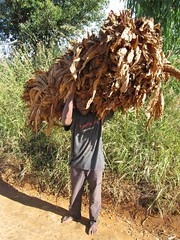 Small tobacco producers carried their produce to depots either on foot, or by bicycle. With the wind behind me I could smell the distinctive tobacco scent often before the large overloaded trucks passed en route to market. Cotton production was on a decent scale; cooperatives had stacks of bales at their depots ready to be weighed and loaded for transportation. About 45km after the major town of Kasungu I reached the village of Chataloma and the turn-off. The bike was loaded on to the vehicle and John drove to Kanyika through a labyrinth of tracks and small villages. We arrived just after sunset. Lucas, the onsite manager and Cosmos, the cook met and looked after us for the two nights we were there. The camp was quiet as no exploration was going on at present – but it was nice to be able to relax away from the busy city.
Small tobacco producers carried their produce to depots either on foot, or by bicycle. With the wind behind me I could smell the distinctive tobacco scent often before the large overloaded trucks passed en route to market. Cotton production was on a decent scale; cooperatives had stacks of bales at their depots ready to be weighed and loaded for transportation. About 45km after the major town of Kasungu I reached the village of Chataloma and the turn-off. The bike was loaded on to the vehicle and John drove to Kanyika through a labyrinth of tracks and small villages. We arrived just after sunset. Lucas, the onsite manager and Cosmos, the cook met and looked after us for the two nights we were there. The camp was quiet as no exploration was going on at present – but it was nice to be able to relax away from the busy city.
Globe has a number of different projects in Malawi. At Kanyika they have found Niobium used to make a specific steel alloy. At Zomba, 300km south of Lilongwe they are involved in a Rare Earth joint venture. Michael explained that rare earth oxides have ‘super conductor’ properties. One of their many uses is to improve the efficiency of some renewable energy resource technologies such as wind turbines.
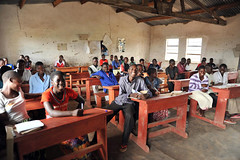 While at Kanyika, I was particularly interested to visit the local Kanyika Secondary School. Globe had financed the production of 100 new desks, employing local artisans to make them. I was pleased to focus on secondary education as so far during this journey I have concentrated on the importance of primary schooling. Dominic arrived at camp just before 9am, having driven almost 200km – an early start for him. We met and learned much from Veronica, the Deputy Head teacher and Joshua Katete, a new teacher at the school.
While at Kanyika, I was particularly interested to visit the local Kanyika Secondary School. Globe had financed the production of 100 new desks, employing local artisans to make them. I was pleased to focus on secondary education as so far during this journey I have concentrated on the importance of primary schooling. Dominic arrived at camp just before 9am, having driven almost 200km – an early start for him. We met and learned much from Veronica, the Deputy Head teacher and Joshua Katete, a new teacher at the school.
The Kanyika Secondary school has four teachers who are expected to teach the 96 students. To cover all the classes, each teacher must be versatile enough to teach four different subjects. Veronica explained that they have to be extremely organised to manage each day, juggling home life, lesson preparation and marking with classes to give the students the best chance of reaching their goals. They had one student qualify for university last year while others were able to move on to their chosen careers. We visited a study class where four senior students were preparing for their final exams; one wanted to be a doctor, another a nurse, one was aiming for the military and the fourth wanted to be a driver.
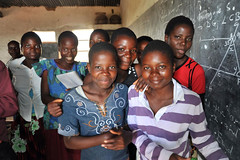 I was keen to ask about the number of girls enrolled, knowing that educating girls is one of the most important issues to help alleviate poverty in the long term. Veronica said that only about 30% of students are female. The main reason is because of early marriages. Typically girls in rural Malawi get married at around 15 years of age and therefore do not have an opportunity at secondary and further education. She said in Malawi, boys and girls are considered of equal importance (unlike in other cultures I came across in the Sahel). Given the problem Malawi has with population control, encouraging girls to stay in school rather than having children at such a young age would help alleviate one of their biggest issues.
I was keen to ask about the number of girls enrolled, knowing that educating girls is one of the most important issues to help alleviate poverty in the long term. Veronica said that only about 30% of students are female. The main reason is because of early marriages. Typically girls in rural Malawi get married at around 15 years of age and therefore do not have an opportunity at secondary and further education. She said in Malawi, boys and girls are considered of equal importance (unlike in other cultures I came across in the Sahel). Given the problem Malawi has with population control, encouraging girls to stay in school rather than having children at such a young age would help alleviate one of their biggest issues.
Globe isn’t the only contributors to Kanyika School. Funding has been received from the European Union and the Malawi Government. School fees, which are about $US70 per annum used to go straight to the government to then be distributed to which ever schools they saw fit, whereas now the government now allows the fees to be managed by the school to be better directed to whichever area needs it. I visited a second form class in the original school buildings opposite the new EU funded block. In Malawi there are four forms at secondary level. The class was studying for their biology exams. They were a pretty rowdy lot, so I’m not sure how much study was getting done.
 Before leaving, I invited the teachers back to Globe’s camp in the afternoon to try to connect them with the BTC education program. They were keen, arriving at camp in the mid-afternoon. I spent the rest of the day educating them on how to use the internet and set Joshua up with a new email address. Lucas said Globe would support by allowing them to use their computer. I did what I could and really hope it gives them a chance to connect with other teachers. I will be difficult, but Lucas said he would follow it up and encourage Joshua and co.
Before leaving, I invited the teachers back to Globe’s camp in the afternoon to try to connect them with the BTC education program. They were keen, arriving at camp in the mid-afternoon. I spent the rest of the day educating them on how to use the internet and set Joshua up with a new email address. Lucas said Globe would support by allowing them to use their computer. I did what I could and really hope it gives them a chance to connect with other teachers. I will be difficult, but Lucas said he would follow it up and encourage Joshua and co.
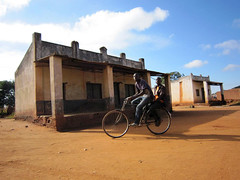 John and I really enjoyed our time at Kanyika. It was a chance to take a closer look at rural life in Malawi, away from the main roads. We left the following morning, winding our way 35km back to the highway through villages and fields of maize, tobacco, sunflowers, cotton and other produce. There was plenty of evidence of the old British colonial days, when the tobacco industry really thrived. Some of the colonial buildings, now mostly dishevelled, were obviously quite grand.
John and I really enjoyed our time at Kanyika. It was a chance to take a closer look at rural life in Malawi, away from the main roads. We left the following morning, winding our way 35km back to the highway through villages and fields of maize, tobacco, sunflowers, cotton and other produce. There was plenty of evidence of the old British colonial days, when the tobacco industry really thrived. Some of the colonial buildings, now mostly dishevelled, were obviously quite grand.
Back on the road, the distant hills and high plains evolved into some serious climbs. The next evening we stayed in the cheap government run lodge set amongst the pine plantations at 1770 metres. Joseph, the manager explained that they were Mexican pines introduced by the British to kick start the forestry industry. Being so high, we were suddenly in an alpine climate where we enjoyed the warmth of a log fire after John cooked a great vegetable soup. Quite a contrast to the heat and humidity experienced so far during the journey.
 The next morning the ascent continued up to about 1900 metres and then a whole lot more arduous work on the bike before descending to Mzuzu for lunch. Some of the cyclists pushing to Mzuzu were carrying incredible loads of firewood to sell. John and I could not work out firstly how they stacked their bikes so high and secondly just how they mounted and manoeuvred them. We talked to and filmed a pair at work – incredible.
The next morning the ascent continued up to about 1900 metres and then a whole lot more arduous work on the bike before descending to Mzuzu for lunch. Some of the cyclists pushing to Mzuzu were carrying incredible loads of firewood to sell. John and I could not work out firstly how they stacked their bikes so high and secondly just how they mounted and manoeuvred them. We talked to and filmed a pair at work – incredible.
Being a decent sized town, we thought we’d find a nice restaurant for lunch for a change from preparing our own food. There I had a brief chat with a couple of MSF (Medicines Sans Frontiers) doctors. I asked what kind of crisis they were dealing with in northern Malawi. The Australian doctor, who had just been with the team for a month said there was nothing specific, more that there were a complete lack of medical facilities and healthcare in the villages. He said that in a village he visited the previous week there were twenty children dead from measles! Hard to believe. The MSF team spent most of their time treating easily preventable diseases.
We turned off the main road to follow the old road from Rumphi to Livingstonia. It wasn’t much extra distance as it ran parallel to the new highway, but the map showed it to be the scenic route. It was good to be off the busy road. I cycled through village after village. Small time tobacco producers were busy with harvest – some drinking a bit too much of their harvest money away in celebration. The track was indeed incredibly picturesque, but it had rained overnight and as I hit the higher mountains near the lake there were steep muddy slopes to contend with. Livingstonia is a mission set up by explorer David Livingstone.
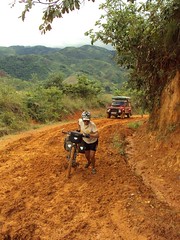 On the finale of the muddy climb to the town, a small truck became bogged in the mud, blocking John’s vehicle. He had to wait until they freed their truck, making a causeway of grass and sticks to give the tyres something to grip.
On the finale of the muddy climb to the town, a small truck became bogged in the mud, blocking John’s vehicle. He had to wait until they freed their truck, making a causeway of grass and sticks to give the tyres something to grip.
I simply pushed my bike around the mess and on to the mission. It’s a stunning place; plenty of history and incredible views over Lake Malawi.
Lake Malawi is Africa’s third biggest lake, about 600km long and very deep. It is at the southern tip of the Great Rift Valley which we will be travelling through all the way to where it reaches the Red Sea (also part of the same fault in the Earth’s surface).
I had always wanted to visit the Rift Valley, and so reaching Lake Malawi was an important landmark for me. From Livingstonia it was 18km of extremely steep downhill on rocky slopes with loose large gravel stones. It was a serious workout for my brakes and I eased down the mountain almost as slowly as I climbed it, concentrating intensely on keeping control. It was equally a stern test for the John in the LandRover. Every now and then we would get spectacular glimpses of the lake, right across to the mountains of southern Tanzania on the eastern shoreline.
Ten kilometres down the highway we stopped in at Sangilo Sanctuary Lodge, recommended by our friends from Globe. The plan was just to stop and camp for the night, but it was such an idyllic place, I decided to take our rest day early. Terrific food and company and our own private sandy beach to look out over the lake! Not a bad place to spend a catch-up day. Anne and Ian, who were caretaking the place for ten weeks, really took care of us. Cyril from Resource Star Ltd kindly took care of our expenses.
From there it was a simple day’s ride, passing small villages and rice fields up the coast to through Karonga and on to the Tanzanian border on the Songwe River. I had planned to take the least travelled route from here through central Tanzania to the town of Tabora. The road is not well used and marked as impassable during the wet. It had rained the last two nights and our concern was that this route may not be an option.
A small advertisement – A couple of months ago I wrote a contribution for a book called The Modern Women’s Anthology II, which is about to be released this month. It was a bit of an honour to be included with this group of women which includes Catherine Freeman, Kate Ellis, Cindy Pan, Jane Grieve…there are all sorts of women from different walks of life. There have been some wonderfully positive reviews from international media. To find out more and to order a copy please visit The Modern Woman’s Anthology. Proceeds from the sale of the book go to the Black Dog Institute.




{ 3 comments… read them below or add one }
Great! Sounds like it’s challanging but a lot of fun.
Hie Kate,
where are you? i have liked this article,all the best good work guys
nice to see you article.
Malawi
chikhwawa
Dear Kate,
Fantastic effort. The flies and the mud sound a nightmare. However I guess the wonderful people and spectacular scenery compensate. Take care.
Prue